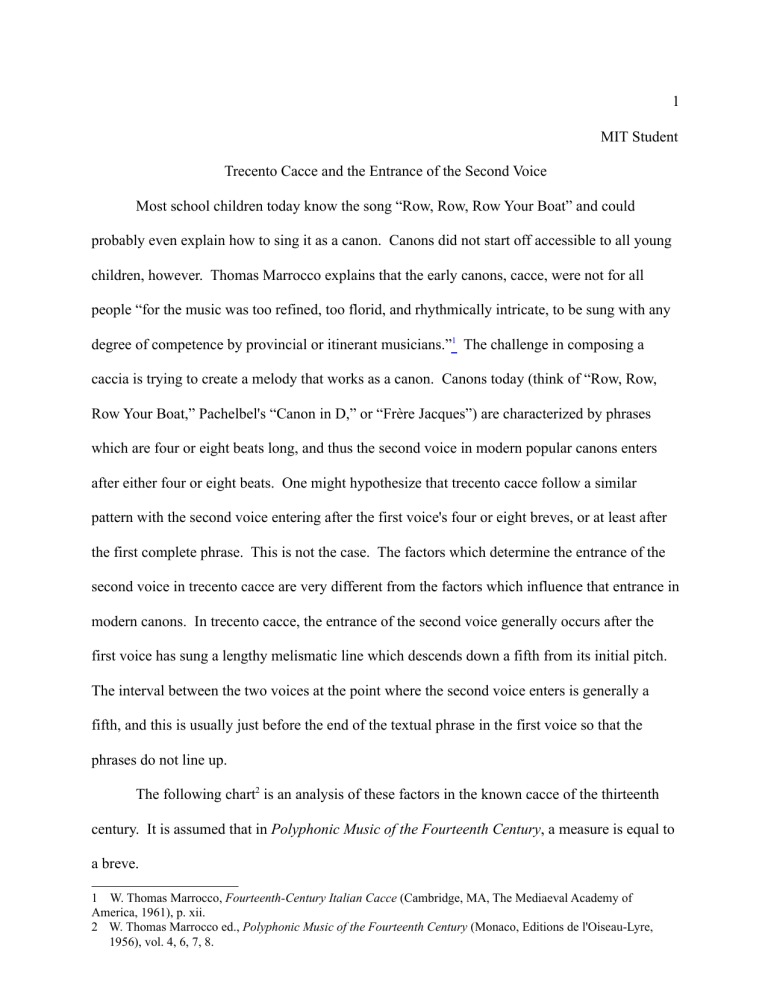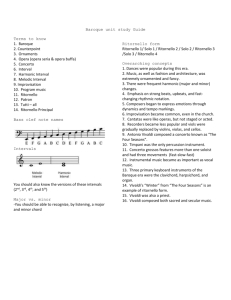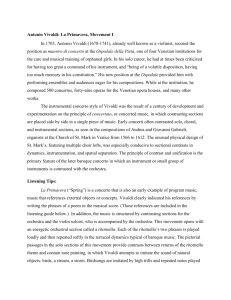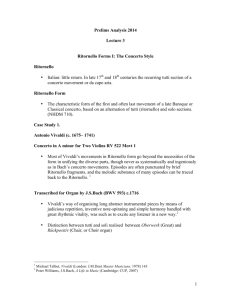1 MIT Student Trecento Cacce and the Entrance of the Second Voice

1
MIT Student
Trecento Cacce and the Entrance of the Second Voice
Most school children today know the song “Row, Row, Row Your Boat” and could probably even explain how to sing it as a canon. Canons did not start off accessible to all young children, however. Thomas Marrocco explains that the early canons, cacce, were not for all people “for the music was too refined, too florid, and rhythmically intricate, to be sung with any
degree of competence by provincial or itinerant musicians.” 1
The challenge in composing a caccia is trying to create a melody that works as a canon. Canons today (think of “Row, Row,
Row Your Boat,” Pachelbel's “Canon in D,” or “Frère Jacques”) are characterized by phrases which are four or eight beats long, and thus the second voice in modern popular canons enters after either four or eight beats. One might hypothesize that trecento cacce follow a similar pattern with the second voice entering after the first voice's four or eight breves, or at least after the first complete phrase. This is not the case. The factors which determine the entrance of the second voice in trecento cacce are very different from the factors which influence that entrance in modern canons. In trecento cacce, the entrance of the second voice generally occurs after the first voice has sung a lengthy melismatic line which descends down a fifth from its initial pitch.
The interval between the two voices at the point where the second voice enters is generally a fifth, and this is usually just before the end of the textual phrase in the first voice so that the phrases do not line up.
The following chart 2 is an analysis of these factors in the known cacce of the thirteenth
century. It is assumed that in Polyphonic Music of the Fourteenth Century , a measure is equal to a breve.
1 W. Thomas Marrocco, Fourteenth-Century Italian Cacce (Cambridge, MA, The Mediaeval Academy of
America, 1961), p. xii.
2 W. Thomas Marrocco ed., Polyphonic Music of the Fourteenth Century (Monaco, Editions de l'Oiseau-Lyre,
1956), vol. 4, 6, 7, 8.
Composer
Magister Piero
Giovanni da Firenze
Jacopo da Balogna
Title
Chavalcando
Chon brachi assai ritornello
Con dolce brama
Ogni dilecto
Chon brachi assai ritornello
Nel boscho senca folglie ritornello
Per larghi prati
Giunge 'l bel tempp
Ogelletto silvagio
Per sparverare
Vincenzo da Rimini
Donato da Firenze
In forma quasi
Nell'acqua chiara
Faccia chi de' se'l po' ritornello
Gherardello da Firenze Tosto che l'alba ritornello
Lorenzeo da Firenze
Anonymous
A poste messe
Or qua, conpagni
Quan ye voy le duc
Niccolò da Perugia
Francesco Landini
Reggio Emilia
Seghugui a corta
Dappoi che'l sole ritornello
La fiera testa
Passando con pensier ritornello
State su, donne ritornello
De! dinmi tu ritornello
Chosi pensoso ritornello
Mirando i pessi
Nella foresta
Chiama il bel papagallo ritornello
4
5
10
8
1
6
2
4
6
# breves
4
8
1
14
6
9
4
10
6
5
3
13
14
7
8
8
5
5
9
4
4
11
16
6
4
4
6
4
22
Overlap breves
7
10 (14)
3 (4)
1
4
2
7
7 (10)
2
2
10
7
9 (16)
18 (20)
3 (4)
2
3
4
9
1
2* (minus minim)
4* (minus minim)
11
5
2* (minus minim)
6
1
4
3
2
6
2
4
3* (minus minim)
1* (minus minim)
5
6
2
5 th
5 th
3 rd
5 th
8va
5 th
5 th
Unison
8va
8va
8va
5 th (below)
5 th
Unison
5 th
3 rd
8va
3 rd
6 th
Unison
5 th
5 th
5 th
8va
5 th
5 th
5 th
5 th
Interval
5 th
5 th
5 th
5 th
8va
5 th
5 th
5 th
5 th (3 voice)
5 th
3
The third column in this chart is the number of breves in the first voice before the entrance of the second. The fourth column is the interval between the two voices at the point where the second voice enters (the second voice is higher than the first voice unless noted), and the final column is the number of breves from the point the second voice enters until the end of the line of text in the first voice with the number in parentheses including breves of rest before the next entrance of the
first voice. The last three cacce, those by Reggio Emilia, are recently discovered cacce.
One might wonder after examining this chart why there is no information in it regarding the tenor voice, which is present in all cacce examined. In fact, the tenor in an Italian trecento caccia can be described as a non-essential “harmonic enrichment” to the two canonic voices
which together provide the essential harmony.
Thus no information about the tenors in these trecento cacce is provided in the above table.
Some rows of this chart are marked “ritornello.” A ritornello is a separate section of a caccia (or madrigal) which contains the musical setting of the last two lines of the text and which
is frequently distinguished by a change of meter.
These rows marked “ritornello” contain the information about the ritornello section of the caccia in the row above it if that ritornello is also canonic..
After an analysis of the number of breves in the first voice before the entrance of the second voice, one discovers that there is no clear pattern. Unlike in our modern canons, trecento cacce have a great variation in how many breves occur before the second voice enters. The number of breves among these cacce ranges from 4 to 22 breves in the main section, and between
1 and 16 breves in the ritornello. It should be noted that in every caccia examined, the second
3 Marco Gozzi and Agostino Ziino, “The Mischiati Fragment: a new source of Italian Trecento music at Reggio
Emilia,” in Sandra Dieckmann, Oliver Huck, et al., eds., Kontinuitaet und Transformation in der italienischen
Vokalmusik zwischen Due- und Quattrocento, Musica Mensurabilis 3 (Hildesheim: Georg Olms Verlag, 2007), pp. 281-314.
4 Newes, “Chace, Caccia, Fuga,” p. 30.
5 Lalage Cochrane, “Ritornello,” Grove Music Online .
voice enters after an exact number of breves; it never enters with a pick-up to the next measure.
There is much more of a pattern to be observed in the interval between the two voices at the point where the second voice first enters. Examination of the chart shows that this interval is
4 almost always a fifth. Most of the cacce examined begin with a long melisma in the first voice
which eventually descends a fifth, at which point the second voice enters.
exactly what happens in La Fiera Testa
by Niccolò da Perugia pictured below 7 . Perhaps the most
Courtesy of Éditions de l'Oiseau-Lyre S.A.M. Used with permission.
glaring irregularity in the list of intervals between the two canonic voices at the entrance of the second voice is in the piece Quan ye voy le duc. This piece, however, is not actually an Italian cacce but rather the text is French, suggesting that it may not even belong in the table. There are enough other similarities between this piece and Italian cacce, however, that it is with including.
The example above also demonstrates the overlapping text phrase listed in the last column of the table. Observe that in La Fiera Testa above, the first line of text corresponds to
6 Marrocco, Cacce , p. xvi.
7 Marrocco, Polyphonic Music , v.8 p. 141.
the first six measures of the piece, but the second voice enters in measure five. This overlapping
5 of text phrases is also typical of Italian trecento cacce. In fact, every caccia examined has text phrases which overlap, whereas there are some cacce for which the interval between the two voices at the point where the second voice enters is a unison or octave, or even more rare, a third or sixth. An interesting topic of further study would be to examine whether the lengths of phrases after the first voice re-enters are uniform so that the two voices never end or begin a phrase together, or whether there is a great variety to the lengths of phrases later in the cacce.
An analysis of the four cacce of Niccolò da Perugia will provide insight into what other factors may influence the entrance of the second voice in a caccia. Four cacce of Niccolò are currently known, more than any other trecento composer but Magister Piero. More canons of
Niccolò are known, however, because three of his four cacce have canonic ritornello sections where as only one of Piero's has a canonic ritornello.
The first of Niccolò's cacce, Dappoi che 'l sole, begins with the first voice on D for four beats, followed by a meandering melismatic section for eight beats, then four more beats of text before the second voice enters. The entrance of the second voice occurs at the time when the first voice is at its lowest point so far. Since we do not know in what order Niccolò da Perugia composed the three parts, it is difficult to determine whether the tenor was done after the other two voices, and thus whether the tenor line had any impact on the entrance of the second voice.
The ritornello section begins similarly, with the first voice beginning a fifth higher on A. Eight measures later the second voice comes in on that same A, forming a fifth with the first voice which is then on a D. As in the beginning of the piece, this D in the top voice is the lowest important note so far, as the C's which occur are embellishments. Unlike the beginning of the piece, at the ritornello the first voice has only one syllable before the second voice enters, so the melisma is six measures long instead of four. Perhaps the best guess for the placement of the
entrance of the second voice is that Niccolò da Perugia liked the lengthy melisma at the beginning of the ritornello, and wanted the same number of measures in the beginning of the piece to match the number of measures in the ritornello section before the second voice enters.
The second of Niccolò's cacce, La fiera testa, begins with a much shorter melisma than
Dappoi che 'l sole , with only six beats on the first syllable before the second syllable is sung.
The first voice has five measures or breves to sing before the second voice joins. Also unlike in
Dappoi che 'l sole, the second voice does go below its pitch where the second voice joins before that point. When the second voice joins, the first voice is on an F, but the measure before that
6 one is dominated by E's in the top voice. The ritornello of La fiera testa is not canonic, so it will not be discussed. Throughout the first section of La fiera testa the phrases, with one exception at measure 26 where there is an extra bar, the phrases are quite regularly five measures long. This regular phrase length can easily be observed as every fifth bar is primarily quarter notes and half notes, whereas the rest of the measures are dominated by sixteenth notes in at least one of the voices. This five-bar phrase structure of La fiera testa requires that the second voice enter after the first five-bar phrase, which is interesting if one recalls the earlier discussion of this piece with regards to the text of the two voices being offset a measure from each other. Though the musical phrases in La fiera testa are quite consistently five measures long, each line of text does not
correspond with a musical phrase. Measures 5 and 6 are displayed below 8 , and one can see that
in measure six, the beginning of the new melodic phrase, the top voice is ending the text phrase while the second voice is beginning a new phrase. Though it would be interesting if the two
8 Marrocco, Polyphonic Music , v.8 p. 141.
Courtesy of Éditions de l'Oiseau-Lyre S.A.M. Used with permission.
voices continued to alternate between beginning and ending the text phrases at the long notes
7 which occur every 5 bars, that is not the case. This phrase structure of having longer notes every fifth bar, however, is what determines the entrance of the second voice in La fiera testa.
Passando con pensier , like the previous two cacce examined, starts out with a melismatic first voice. The first voice stays on the first syllable until the entrance of the second voice, unlike the previous two, and as in Dappoi che 'l sole , the place where the second voice enters is at the lowest point in the top voice up to that bar. What is perhaps most striking about Passando con pensier is its unusual looking rhythm. The way it is transcribed, there is a bar of 3/4, a bar of 2/4, then two more bars of 3/4, as seen below
9 . This metric block is then repeated throughout the first
Courtesy of Éditions de l'Oiseau-Lyre S.A.M. Used with permission.
section. Unlike La fiera testa , though, the beginnings or endings of phrases do not clearly line up with these metric blocks. However, it is likely this metric pattern which dictates the entrance of the second voice in the fifth bar after the first metric block. The ritornello section of Passando con pensier follows a similar pattern with four bar segments, though unlike in the first section these four bars all have the same number of beats. In the ritornello, the longer notes fall on the first bar of each of the four bar segments, as they did in La fiera testa . A couple of other things of note in the ritornello are that the first voice begins with a long note followed by a melismatic
9 Marrocco, Polyphonic Music , v.8 p. 165.
section on the first syllable, then has two more beats with syllables before the second voice enters. Unlike in Dappoi che 'l sole and the first section of Passando con pensier , the first voice goes as much as a fourth below the pitch it is at when the second voice enters. This could be to
8 tie it in to the beginning of the piece, where the first voice is an octave below the second voice when the second voice enters. Perhaps Niccolò da Perugia wanted to recall that octave between voices, but not have the two voices in octaves at the entrance of the second voice so he put the lower octave in the measure before the entrance of the second voice in the ritornello. The entrance of the second voice in the ritornello is dictated by the four-bar phrases established in the first section of Passando con pensier . In the first section the second voice entered after four bars of the first voice, and the ritornello imitates that with the second voice again entering after four bars of the first voice.
The fourth cacce of Niccolò da Perugia, State su, donne , starts out quite differently from the other three. There is no melisma in the first voice; the music is quite syllabic. The first voice also begins moving upward from E to A, a fourth above the starting pitch whereas the other cacce only venture as far as one step above the starting pitch before descending to either the fifth or octave below that starting pitch. The lack of melisma in the opening of the first voice leads to a much greater emphasis on the text of the piece. The textual phrases overlap so that the top two voices do not end together until the end of the first section. In a couple of places, for example bars 60, 107, and 113, the two voices begin new phrases at the same time, but observing the preceding measures, 59, 106, and 112, Niccolò has one voice or the other cut off early so that they do not end at quite the same time. This intentional holding over of one of the voices when he easily could have had both end their phrases simultaneously suggests that the overlapping of textual phrases in State su, donne was the desired effect in the composition of the piece. This overlapping phrase structure limits the number of places the second voice can enter, and the way
9
Niccolò wrote it the second voice enters on the last syllable of the first voice's phrase so as to just barely overlap the phrases, drawing attention to the fact that they do not quite line up. Such overlapping phrases also occur in the ritornello, though with only two phrases in 22 measures it is much less striking. The ritornello follows much more of the melodic style of the other three cacce, with the top voice primarily descending until it reaches the pitch one fifth below its start, though it does dip below that pitch before the entrance of the second voice. Again it is lacking in melisma and quite syllabic, and as in the first section of State su, donne , the second voice enters when the first voice is at the last beat of its phrase. Thus we see that it is the textual emphasis in
State su, donne determines the entrances of the second voice in relation to the text of the first phrase.
Observing that many different aspects of the music in the cacce of Niccolò da Perugia, melodic phrases, textual phrases, melismatic lines, or metric units, seem to determine the entrance of the second voice in each of the pieces we can conclude that each caccia is written individually and not from a template caccia which would determine aspects of the piece such as where the second voice enters. Though a variety of factors influence the entrance of the second voice in the cacce of Niccolò, these factors do not contradict the general trends observed through all of the known trecento cacce. In Niccolò's cacce and in the other trecento cacce, the entrance of the second voice generally occurs after the first voice has completed a lengthy descending melisma. The interval between the two voices at that point is usually a fifth, and this usually occurs just before the text phrase in the first voice has ended. It would be interesting in the future to examine more closely the length of the text phrases and the overlapping of the text phrases between the two voices in the known trecento cacce as the table at the beginning shows that this overlap in text phrases occurs in every single known cacce.
Bibliography
Cochrane, Lalage. “Ritornello.” The Oxford Companion to Music . Ed Alison Latham. Grove
Music Online, http://www.oxfordmusiconline.com/subscriber/article/opr/t114/e5690
(accessed November 10, 2010).
Gozzi, Marco and Agostino Ziino. “The Mischiati Fragment: a new source of Italian Trecento music at Reggio Emilia.” In Sandra Dieckmann, Oliver Huck, et al., eds., Kontinuitaet und Transformation in der italienischen Vokalmusik zwischen Due- und Quattrocento.
Musica Mensurabilis 3 (Hildesheim: Georg Olms Verlag, 2007). pp. 281-314.
Kelly, Stephen Kevin. “The Works of Niccolò da Perugia.” PhD diss., Ohio State University,
1974.
Marrocco, W. Thomas. Fourteenth-century Italian Cacce.
Cambridge, Mass., The Mediaeval
Academy of America, 1961.
Newes, Virginia. “Chace, Caccia, Fuga: The Convergence of French and Italian Traditions.”
Musica Disciplina 41 (1987). pp. 27-57.
Marrocco, W. Thomas ed. Polyphonic Music of the Fourteenth Century . Monaco, Editions de l'Oiseau-Lyre, 1956. vol 4,6,7,8.
10
MIT OpenCourseWare http://ocw.mit.edu
21M.220 / Early Music
Fall 2010
For information about citing these materials or our Terms of Use, visit: http://ocw.mit.edu/terms .




